
PSYC 137 Week 4
Social Memory
How is memory linked to perception?
our background knowledge can influence our perspective on a person
memory as background of perception
knowledge, beliefs, expectations
memory and byproduct of perception
once we see someone, they become familiar, we remember something about them, we create a new memory
record of perceptual activity
Memory of the Person (Person Memory)
the first study on perception of the person was based on memory
Solomon Asch’s Experiments (1946)
Ash experiment trying to figure out what are the most important traits essential to form an impression of other people
what he did was show people two lists of words, and then they asked them to read one of the lists and then form an impression later
that's how researchers use memory to discover how people form impression of others
the participants first read about the targets, then report impressions
participants need to remember the list they read
participants have concepts about the traits they were asked
other studies that also rely on memory
the Susan F. example with the faces
social cognition was originally called “person memory”
person memory book first about social cognition 1975
Different Types of (Long-Term) Memory
time difference between long and short-term memory
short term memory = remembering anything less than 30 seconds
long term memory = remembering anything more than 30 seconds
Declarative memory
facts, data, and events
episodic memory
specific events, when, where, and how it relates to ourselves
ex: remembering what you did for your friend’s 10th birthday
semantic memory
abstract statements of facts and knowledge of the world
ex: knowing your friend’s birthday
Procedural memory
how to do things
motor
procedures that underlie motor skills
ex: remembering how to ride a bike
cognitive
procedures that underlie cognitive skills
ex: remembering how to do a math problem/problem-solving skills
How is the Episodic Memory of a Person Represented?
Individual and Reference in Person Memory: Anderson & Hastie (1974)
Present Participants with Different Behaviors of A Target
First, Participants learn about Two Individuals
Gave people a list a behaviors and asked them to memorize them
James Bartlett rescued the kitten.
James Bartlett adopted the child.
The lawyer caused the accident.
The lawyer cursed the salesgirl
Present Participants with Different Behaviors of A Target
Then, Participants Learn that the Two Individuals Were the Same
James Bartlett is the lawyer
Finally, Participants were asked questions about James and the lawyer
Did James Bartlett cause the accident?
How are these behaviors encoded in memory?
Hypothesis 1: Single Representation
one single representation representing this person who is both James and the lawyer, and then this person perform 4 different behaviors

Hypothesis 2: Barlett first has the good actions and then connect it to lawyer has the bad actions
the second hypothesis is that there are two notes represented to person, James Bartlett did two things lawyer did the other two things, and they are linked later on, because this is how exactly the participant learned
they first learned about this person and that person and later learned that they are related
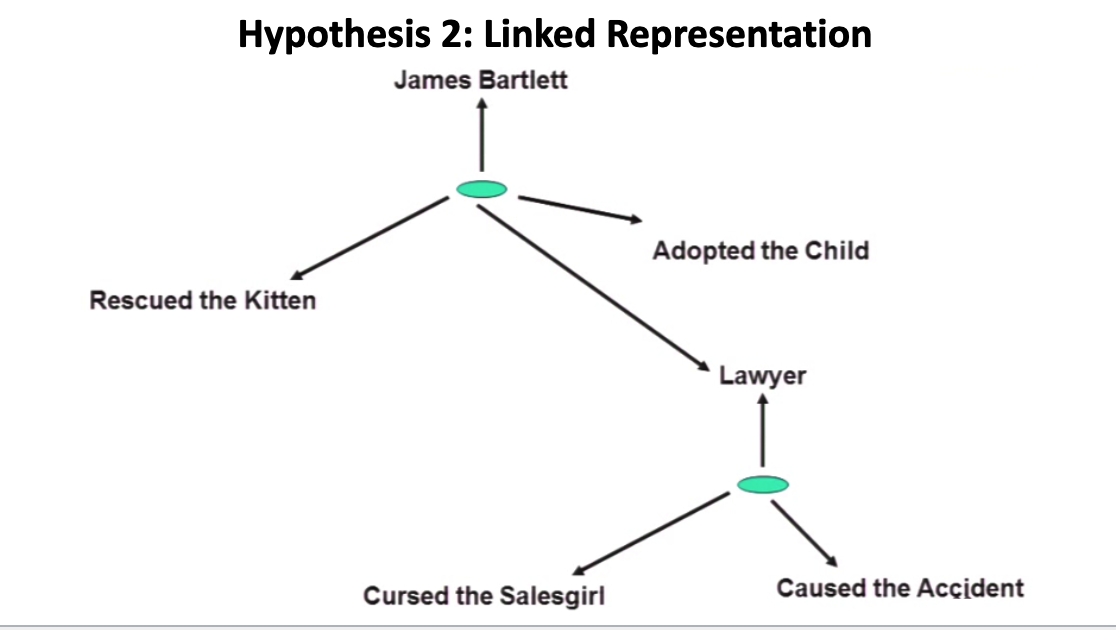
How can you test which hypothesis is more likely?
ask different questions, track response time
showed that if hypothesis 1 is accurate they should be able to answer if he caused the accident or rescued the kitten, in the same amount of time
If hypothesis 2 is accurate they should be able to answer that he rescued the kitten faster than answering that he caused the accident
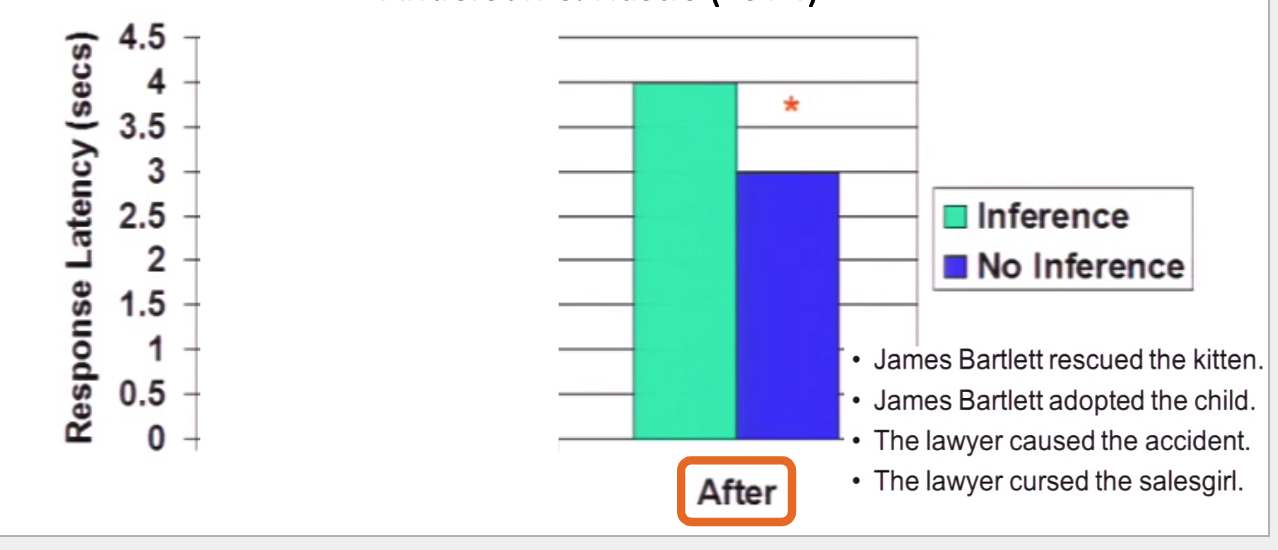
showed that hypothesis 1 isn’t the true model
they found that when people are asking questions that require no inference, they were significantly faster in answering than question that required inference
found that this is only the case if people are first presented with this information of two presumably different individuals, and they were told that the two individuals were the same later
if you gave them all of the information at once and not sequentially it showed not much of a significant difference between making inferences or not
Suggesting that when you tell people two things about two presumably different people at the same time and tell them that, hey, remember James Bartlett is the lawyer, people actually were able to consolidate the memory into just joining them into one note
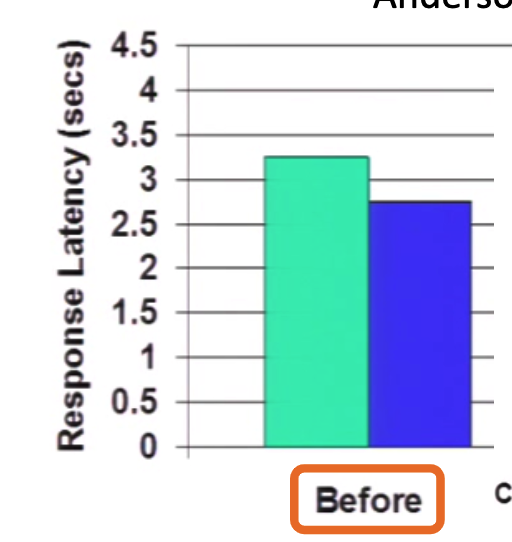
Conclusion
how a person is represented in memory depends on how you learned about them
How is Episodic vs. Semantic Memory of a Person Represented?
Hypothesis 1: traits and behavior represented independently
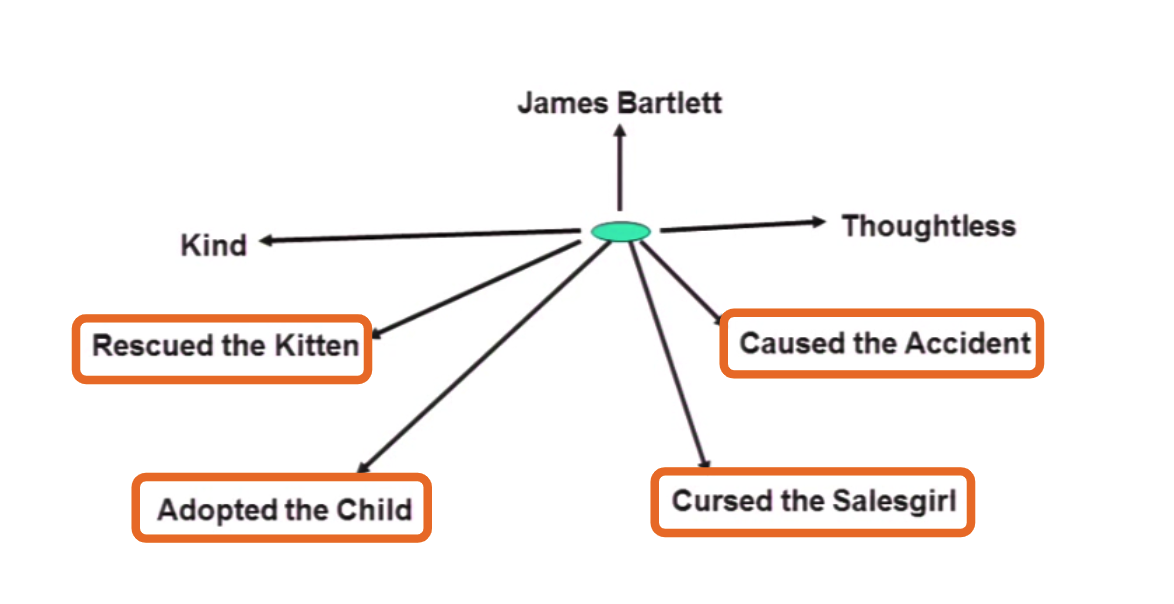
Hypothesis 2: behaviors clustered by traits
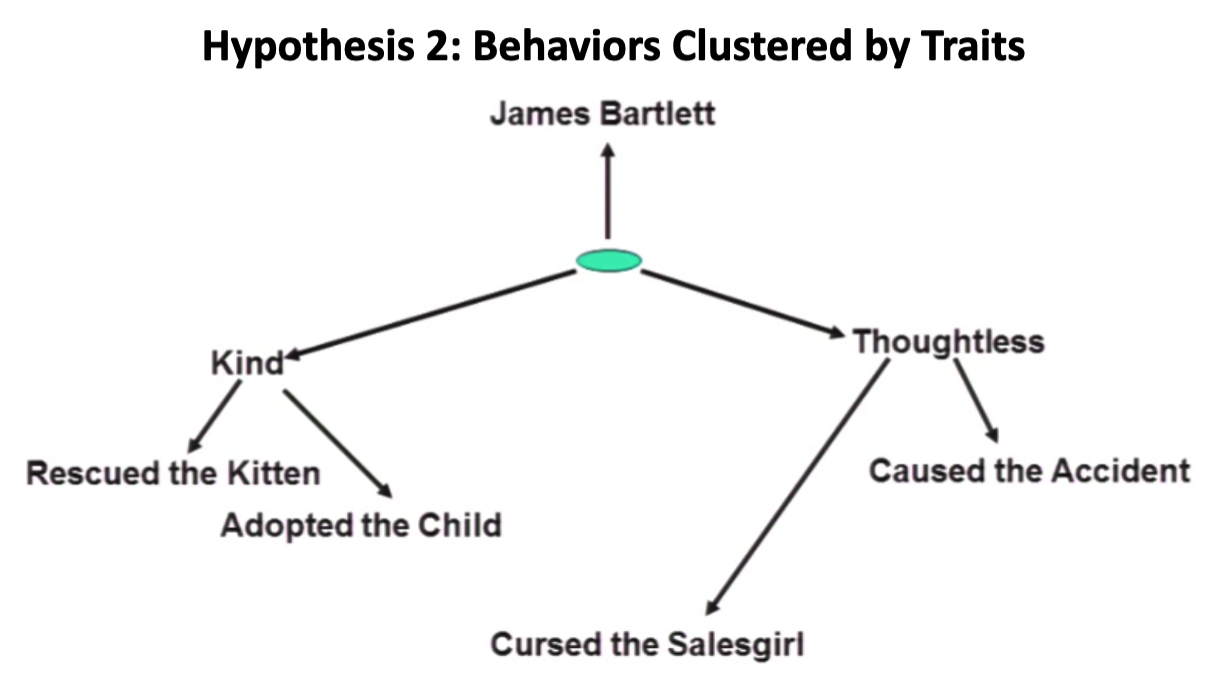
How did they test this?
Organization of Person Memory: Klein & Loftus (1990)
Participants Were Presented 20 Behavior Descriptions
Implying 5 different traits, 4 descriptions per traits
ex: Athletic, Intelligent, Honest, Religious, Sociable
ex of behavioral description that could imply athletic: James ran a marathon
classification condition
given 20 behavior descriptions and asked to sort them into different categories and most people do it by the traits they imply
impression condition
just form an impression based on the behavior
memorization condition
memorize all these behavior items
People spontaneously infer traits given behavior descriptions
ex: Klein joined the softball practice last night. Klein goes to the church every Sunday. Klein likes talking to other people at the softball event
assuming that people will infer this person is athletic
Participants Were Asked to Do One of the Following
Form an Impression of the Person
did it without you explicitly asking them
Memorize the Behavior Descriptions
Categorize the Behavior Descriptions
Finally, Participants Were Asked To Recall The Descriptions
When recalling behavior descriptions are they clustered by the traits?
only showed clusters when they were explicitly asked to cluster the behavior (the classification part)
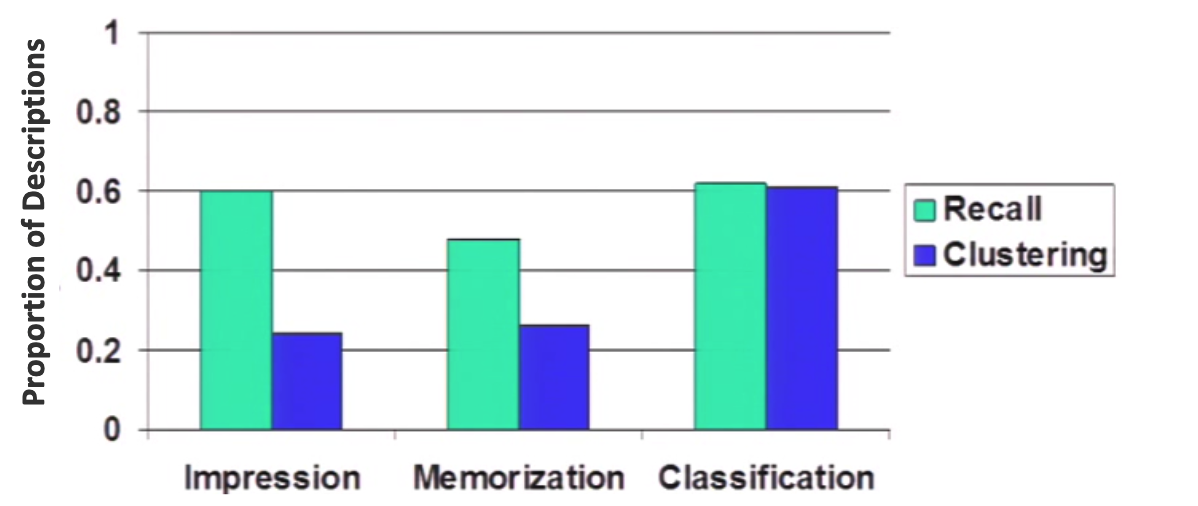
by just looking at the recall part they reached the conclusion that in all conditions, participants spontaneously infer traits
even though they didn’t present the trait information, the assumption and also the fact is that people spontaneously infer the traits
the way the clustering part is classified is when the person starts to record the behavior, they tend to recall behavior belonging to the same group related to the same trait
ex: Klein is running a marathon on saturday. She also ran with her friend yesterday. She is also taking soccer classes….
when the people were explicitly asked to cluster the desription
we found that most of the recall were actually recalled by clusters by the traits
but for impression and memorization, when people were not explicitly asked to classify the behavior, but instead of just form an impression or memorize the description, we see much fewer evidence of clustering and it's actually not significantly different from chance.
Conclusion
Hypothesis 2 is wrong because there was no order for the memorization or impression part
behaviors and traits are represented independently
Hypothesis 1 is the true model
does this mean episodic memory and semantic memory do not influence each other?
no, how a person is represented in memory depends on how you learn about them
behaviors and traits are represented independently but only when you learn behaviors first
what happens if you learn the traits first and then the behavior information?
then semantic and episodic memory might have a relation
Schematic Effects on Person Memory: Hastie & Kumar (1979)
Participants Were Presented with List of Traits that are pretty consistent describing A Target
Induce A Schema of What the Target Person Is Like
ex: Judy is intelligent, quick, wise, knowledgable, decisive
Participants Were Presented with List of Behavior Descriptions
Schema-Congruent
ex: Judy did great on her exam.
Schema-Incongruent
ex: Judy did terrible on her exam.
Schema-Irrelevant
ex: Judy likes to play tennis
Lastly, participants were asked to recall the behavior descriptions
More people were able to recall the incongruent
why?
more time being spent thinking about incongruent?
it sticks out more?
expectation?
Recall of behaviors differed across conditions

Conclusion
we remember the irrelevant things the least
if people learn about the person by looking at their traits first, traits do influence the encoding of the behavioral information
traits influence behavior representation in memory if you learn about the traits first
HOW YOUR MEMORY WORKS ALL DEPENDS ON HOW YOU LEARN ABOUT THE INFORMATION
If you learn about the traits first, then this schema about the person is going to influence how you remember the behavioral information
On the contrary, if you learn about the behavioral information first in the last study, then the encoding of behavioral information and the traits is relatively independent
This is called the schematic processing principle
the memorability of an event is a function of its relationship to pre-existing schemata
PSYC 137 Week 4
Social Memory
How is memory linked to perception?
our background knowledge can influence our perspective on a person
memory as background of perception
knowledge, beliefs, expectations
memory and byproduct of perception
once we see someone, they become familiar, we remember something about them, we create a new memory
record of perceptual activity
Memory of the Person (Person Memory)
the first study on perception of the person was based on memory
Solomon Asch’s Experiments (1946)
Ash experiment trying to figure out what are the most important traits essential to form an impression of other people
what he did was show people two lists of words, and then they asked them to read one of the lists and then form an impression later
that's how researchers use memory to discover how people form impression of others
the participants first read about the targets, then report impressions
participants need to remember the list they read
participants have concepts about the traits they were asked
other studies that also rely on memory
the Susan F. example with the faces
social cognition was originally called “person memory”
person memory book first about social cognition 1975
Different Types of (Long-Term) Memory
time difference between long and short-term memory
short term memory = remembering anything less than 30 seconds
long term memory = remembering anything more than 30 seconds
Declarative memory
facts, data, and events
episodic memory
specific events, when, where, and how it relates to ourselves
ex: remembering what you did for your friend’s 10th birthday
semantic memory
abstract statements of facts and knowledge of the world
ex: knowing your friend’s birthday
Procedural memory
how to do things
motor
procedures that underlie motor skills
ex: remembering how to ride a bike
cognitive
procedures that underlie cognitive skills
ex: remembering how to do a math problem/problem-solving skills
How is the Episodic Memory of a Person Represented?
Individual and Reference in Person Memory: Anderson & Hastie (1974)
Present Participants with Different Behaviors of A Target
First, Participants learn about Two Individuals
Gave people a list a behaviors and asked them to memorize them
James Bartlett rescued the kitten.
James Bartlett adopted the child.
The lawyer caused the accident.
The lawyer cursed the salesgirl
Present Participants with Different Behaviors of A Target
Then, Participants Learn that the Two Individuals Were the Same
James Bartlett is the lawyer
Finally, Participants were asked questions about James and the lawyer
Did James Bartlett cause the accident?
How are these behaviors encoded in memory?
Hypothesis 1: Single Representation
one single representation representing this person who is both James and the lawyer, and then this person perform 4 different behaviors

Hypothesis 2: Barlett first has the good actions and then connect it to lawyer has the bad actions
the second hypothesis is that there are two notes represented to person, James Bartlett did two things lawyer did the other two things, and they are linked later on, because this is how exactly the participant learned
they first learned about this person and that person and later learned that they are related

How can you test which hypothesis is more likely?
ask different questions, track response time
showed that if hypothesis 1 is accurate they should be able to answer if he caused the accident or rescued the kitten, in the same amount of time
If hypothesis 2 is accurate they should be able to answer that he rescued the kitten faster than answering that he caused the accident

showed that hypothesis 1 isn’t the true model
they found that when people are asking questions that require no inference, they were significantly faster in answering than question that required inference
found that this is only the case if people are first presented with this information of two presumably different individuals, and they were told that the two individuals were the same later
if you gave them all of the information at once and not sequentially it showed not much of a significant difference between making inferences or not
Suggesting that when you tell people two things about two presumably different people at the same time and tell them that, hey, remember James Bartlett is the lawyer, people actually were able to consolidate the memory into just joining them into one note

Conclusion
how a person is represented in memory depends on how you learned about them
How is Episodic vs. Semantic Memory of a Person Represented?
Hypothesis 1: traits and behavior represented independently

Hypothesis 2: behaviors clustered by traits

How did they test this?
Organization of Person Memory: Klein & Loftus (1990)
Participants Were Presented 20 Behavior Descriptions
Implying 5 different traits, 4 descriptions per traits
ex: Athletic, Intelligent, Honest, Religious, Sociable
ex of behavioral description that could imply athletic: James ran a marathon
classification condition
given 20 behavior descriptions and asked to sort them into different categories and most people do it by the traits they imply
impression condition
just form an impression based on the behavior
memorization condition
memorize all these behavior items
People spontaneously infer traits given behavior descriptions
ex: Klein joined the softball practice last night. Klein goes to the church every Sunday. Klein likes talking to other people at the softball event
assuming that people will infer this person is athletic
Participants Were Asked to Do One of the Following
Form an Impression of the Person
did it without you explicitly asking them
Memorize the Behavior Descriptions
Categorize the Behavior Descriptions
Finally, Participants Were Asked To Recall The Descriptions
When recalling behavior descriptions are they clustered by the traits?
only showed clusters when they were explicitly asked to cluster the behavior (the classification part)

by just looking at the recall part they reached the conclusion that in all conditions, participants spontaneously infer traits
even though they didn’t present the trait information, the assumption and also the fact is that people spontaneously infer the traits
the way the clustering part is classified is when the person starts to record the behavior, they tend to recall behavior belonging to the same group related to the same trait
ex: Klein is running a marathon on saturday. She also ran with her friend yesterday. She is also taking soccer classes….
when the people were explicitly asked to cluster the desription
we found that most of the recall were actually recalled by clusters by the traits
but for impression and memorization, when people were not explicitly asked to classify the behavior, but instead of just form an impression or memorize the description, we see much fewer evidence of clustering and it's actually not significantly different from chance.
Conclusion
Hypothesis 2 is wrong because there was no order for the memorization or impression part
behaviors and traits are represented independently
Hypothesis 1 is the true model
does this mean episodic memory and semantic memory do not influence each other?
no, how a person is represented in memory depends on how you learn about them
behaviors and traits are represented independently but only when you learn behaviors first
what happens if you learn the traits first and then the behavior information?
then semantic and episodic memory might have a relation
Schematic Effects on Person Memory: Hastie & Kumar (1979)
Participants Were Presented with List of Traits that are pretty consistent describing A Target
Induce A Schema of What the Target Person Is Like
ex: Judy is intelligent, quick, wise, knowledgable, decisive
Participants Were Presented with List of Behavior Descriptions
Schema-Congruent
ex: Judy did great on her exam.
Schema-Incongruent
ex: Judy did terrible on her exam.
Schema-Irrelevant
ex: Judy likes to play tennis
Lastly, participants were asked to recall the behavior descriptions
More people were able to recall the incongruent
why?
more time being spent thinking about incongruent?
it sticks out more?
expectation?
Recall of behaviors differed across conditions

Conclusion
we remember the irrelevant things the least
if people learn about the person by looking at their traits first, traits do influence the encoding of the behavioral information
traits influence behavior representation in memory if you learn about the traits first
HOW YOUR MEMORY WORKS ALL DEPENDS ON HOW YOU LEARN ABOUT THE INFORMATION
If you learn about the traits first, then this schema about the person is going to influence how you remember the behavioral information
On the contrary, if you learn about the behavioral information first in the last study, then the encoding of behavioral information and the traits is relatively independent
This is called the schematic processing principle
the memorability of an event is a function of its relationship to pre-existing schemata